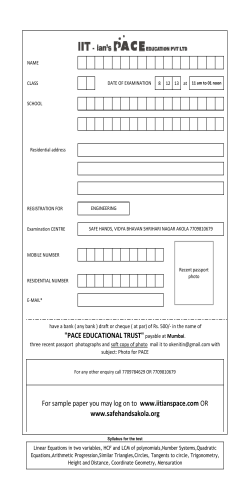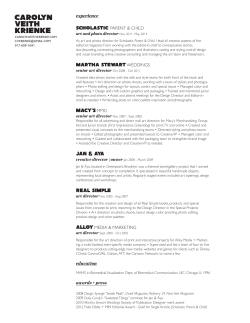
FOREST SURVEY MEMO 08:12:31 Robin Bell 2007
2008d FOREST SURVEY MEMO 08:12:31 Robin Bell 2007 Promotion of pre-digital forest survey procedures Hyperlink Menu Bell, 2007 FSM 07 12 31 Bell, 2008a FSM 08 12 29 Bell, 2008b FSM 081 11 01 Bell, 2008c FSM 08 12 25 Bell, 2008d FSM 08 12 31 Bell, 2009a FSM 09 01 25 MANUAL RADIAL LINE PLOTTING for FOREST MAPPING Summary Radial line plotting (RLP) is a (low order) form of plotting from stereo air photos: it corrects only for primary distortion / displacement due to elevation - which displacement is radial about the principal point of an air photo and can be major at the photo scale of 1:10,000. The formal method, with dedicated instrumentation, has been historically used for mapping ’from scratch’ extensive areas of Africa (Directorate of Overseas Surveys). Courses were taught at Edinburgh University Ecology & Natural Resources, which was fully equipped (Hilger Watts / Cartographic Engineering). Small scale Manual RLP – similar to plain tabling – has an application in the mapping of : small areas of steeper sloping / irregular terrain in otherwise gentle topography; any place where there is also a lack of pre-existing map control / mapped ground framework features, such as is necessary for detail transfer mapping (Bell, 2007 / Bell, 2009a). Other indications for manual RLP are : lack of formal plotting facilities; truly vertical / commercial quality air photography with negligible tilt; shortage of time / cash to procure a formal plot from a third party; availability of a pains-taking surveyor; forest areas distant from the base line of the photo (but less control is in any case required near the principal point). A proven manual methodology (impressive results) for manual RLP using a stereoscope (Bell, 2008b) and simple tools, is described - for work at or around map scale and photo contact scale of 1:10 000. Brief access to an A3 photocopier with calibrated enlargement / reduction facility is recommended for final scaling of the plot. …………………………………………………………………………………………………… With practice, plotting a single photo overlap, yielding about 10 new control points, Copyright Robin Bell 2007 – Manual radial plotting for forest mapping page 1 of 9 can be achieved in approximately oneline hour. Promotion of pre-digital forest survey procedures – [email protected] 08/02/2014 MANUAL RADIAL LINE PLOTTING Devised by Robin Bell (with acknowledgement to Stephen H Spurr, 1948) Definitions The base map has in practice been the British Ordnance Survey (OS) 1:10 000 scale topographic map. The principal point (PP) of a truly vertical photograph is effectively the dead centre. (For a full definition see Bell, 2008b.) The conjugate principal point (CPP) of the left hand photo of a stereopair is the PP of the right hand photo as seen on the left hand photo, and vice versa. The base line for the purposes of the present procedure is the imaginary or inked line joining the PP and the CPP, the effective line of flight on the photo. Active Control Points (ACPs) are points of known map location (and altitude in the case of stereoplotting). To be used in this process they must be recognisable on the base map and the photo. They are used for the geometric reference to which all the plotted detail is related. Proposed control points (PCPs) are the planned new CPs to be formed through Radial Line Plotting, as extra control for Transfer Mapping (Bell, 2009a). Radial line plotting Plotting that removes from the photo only the displacement caused by altitude, which displacement is radial to the PP. Formal stereoplot / High order plotting (Not covered here) Accurate plotting by sophisticated and expensive plotter requiring a trained operator, which removes all significant distortion / displacement in the photos, needing no base map but only control points (planimetric and altitudinal) per overlap. These control points may be derived with care from an OS base map. Objective of manual radial line plotting To provide and locate additional control points where these are lacking, especially in variable / steep topography - making use of the principle that altitudinal displacement on the photo is radial from the PP. The method is very similar to the traditional terrestrial survey process of plain tabling. Scope For indications see summary, Page 1. In these situations manual radial line plotting can where possible offer a method generally superior to approximate field methods of survey in terms of cost and accuracy. Main equipment and materials / …………………………………………………………………………………………………… Copyright Robin Bell 2007 – Manual radial line plotting for forest mapping page 2 of 9 Promotion of pre-digital forest survey procedures – [email protected] 08/02/2014 Main equipment and materials Good mirror stereoscope, ideally with scanning facility (Bell, 2008b), see page 9; Air photos, truly stereoscopic (minimum 60% overlap) and vertical; ‘Crystal’ clear acetate overlay for photo enhancement (Bell, 2008c); Photocopyable acetate if possible (at least as large as the map area of the overlap). (Ordinary acetate may melt in the copier); Transparent drafting film overlay (eg single mat) about the size of two air photos; Technical pens - red Rotring c 0.2mm, black 0.18mm, Rotring FP 300 or 400 ink Very sharp and tough sewing needle (with home-made finger-gripping device for extensive use); Brief access to a (commercial?) Zoom photocopier (1% interval) Accuracy Accuracy is mainly dependent on True verticality of the photo Meticulous care by the operator / surveyor Accuracy of the OS base map / map control points Identification of control points The main test of accuracy is achieved at the end of the process. If the existing active control points (ACP’s) on the final plot (see below) did not fit the base map closely, then it is likely that there would have been a similar error in the new proposed control points (PCP’s) (see Base length and base line, Page 4 / 5.) Conversely, good fit of ACP’s gives high confidence in the PCP’s. The surveyor must decide if any error in fit is acceptable in the circumstances, bearing in mind the likely cost and accuracy of the alternative approximate field survey methods (See Bell, 2009a, Page 5). Experience has shown over many years that the fit of plot with ACP’s is always excellent. It cannot be over-stressed that the whole operation of manual radial line plotting requires extreme patience and care, especially: correct identification of control points precise location of the points with pin and ruler (Fig 2) and thus maximisation of precision of intersection of the radii. Accidental errors in individual radii can theoretically be combined and seriously multiplied at the radius intersections / control points – see Fig 6. Time required An experienced surveyor will take about one hour to treat one photographic overlap, providing about ten new control points / PCP’s. A much larger job …………………………………………………………………………………………………… Copyright Robin Bell 2007 – Manual radial line plotting for forest mapping page 3 of 9 Promotion of pre-digital forest survey procedures – [email protected] 08/02/2014 (multiple overlaps) may more efficiently be managed by using formal stereoplotting. (But see Fig 8, Page 8) Method Test photos for their verticality Severe lack of verticality in one or other of a stereopair is shown by: o Need for excessive adjustment of y-parallax on the stereoscope when scanning from top to bottom of the field of vision. (The photos must be properly base-lined.) (Bell, 2008b) o Eye strain (remediable by frequent y-parallax adjustment). A further indication is: o Evidence of the aircraft turning significantly and thus banking between two photographs, shown by significant divergence of the two base lines of adjacent photographs - or irregularity in the flight path on flight diagram (as supplied with the air photos). Existing overlay from photo enhancement (Bell, 2008c) Any (‘Crystal’) acetate overlay already stuck to the photo from the photo enhancement process may help protect the photo from the pin, but there should be no ink obscuring or distorting the view of the desired control points, and this acetate might best be set aside till the time of transfer mapping (Bell, 2009a). Choosing control points Choose the proposed (new) Control Points (PCP’s) / “landmarks” in the area lacking map control. (To be useful new control points will not appear on the base map.) In the surrounding area choose Active Control Points (ACP’s) which are suitable reference points visible on both map and photograph ie the usual type of existing ‘map control’. Choose all the control points as far from the baseline as possible, since accuracy is poorer the closer one gets to the base line (Fig 6). Twenty control points is probably the combined practical maximum of PCP’s and ACP’s. Twelve to fourteen and may be easier to handle, especially at first (but see Fig 8). Marking the control points on the photos Mark all control points with great care on both photos, using stereovision to ensure that exactly corresponding points are spotted in red on both photos. Use the red pen and make a small mark prominent enough to be visible through the drafting film overlay. Number the control points neatly on one photo (to be visible through the overlay, Fig 1.) In stereo vision, number the points on the other photo in exactly the same order. Base length and base line/ …………………………………………………………………………………………………… Copyright Robin Bell 2007 – Manual radial line plotting for forest mapping page 4 of 9 Promotion of pre-digital forest survey procedures – [email protected] 08/02/2014 Base length and base line Cut the drafting film overlay (sufficient to cover two photos side by side – Fig 1). Base length (the distance on the photo between PP and CPP) can be measured from either photo. This base length is then scaled up / down to 1:10, 000, and this is done at first approximately by multiplying by the same factor as used in transfer mapping (Bell, 2009a Page 3/4). The factor is found by choosing two points at approximately the same altitude as the base line, and measuring the distance on the map a mm - and the distance on the photo - b mm. The factor is expressed as a / b. The length of this approximately scaled base line is reproduced on the overlay as in Fig 1, running between the overlay principle point (OPP) and Fig 1 the overlay conjugate principal point (OCPP) for the left photo. (Note that when working on the right photo, the OPP and the OCPP will change places.) This overlay will become the ‘plot of indeterminate scale’. If the control points lie on either side of the Fig 2 base line, the base line should be represented appropriately near the centre of the overlay as in Fig 7 . Drawing the first radius, left hand photo *Fixing the drafting film overlay onto the left photo Locate the OPP exactly over the principal point of the left photo. This can most precisely done with a pin if that principle point is also previously marked with a pin prick. (But beware ‘damaging’ somebody else’s photos.) The overlay is then rotated until the approximately scaled up / down base line on the overlay is exactly coincident with the photo base line. Fix the overlay firmly to the photo (masking tape), *Marking radii from the OPP to the PCP’s on the left photo / …………………………………………………………………………………………………… Copyright Robin Bell 2007 – Manual radial line plotting for forest mapping page 5 of 9 Promotion of pre-digital forest survey procedures – [email protected] 08/02/2014 *Marking radii from the OPP to the PCP’s on the left photo Hold the pin into the pricked OPP on the drafting film overlay. Hold the ruler against the pin and rotate it until the edge meets the centre of the red mark (PCP) number one on the left photo (Fig 2). Draw the first radius with the (0.18mm) black pen, and label the line in the position shown (Fig 3). Check Fig 3 that the correct control point has been used. Repeat for all control Labelling the first radius, left hand photo points, finishing with a complete set of labelled radii for the left photo cf Fig 8. Remove the drafting film overlay from the left photo, preparatory to fixing it to the right one. The OPP now becomes the OCPP and vice versa. Repeat the operations described in the last 2 paragraphs above both marked with an asterisk, as in Fig 4, except this time do not draw the complete radius as shown by the dashed line, but only a small portion of the radius where it intersects the corresponding radius from the left photo, and label at the intersection, rather than at the end of the radius. Repeat for all control points. Enhance each intersection with a black dot centralised precisely on the intersection (Fig 8). Check that the black dots lie in the correct configuration relative to the red dots on one of the photos (to prevent identification error at this stage). Accurate scaling and scale correction The black dots / control points on the drafting film overlay / plot now lie in their correct physical configuration but at an indeterminate scale. (If it had been possible to accurately scale the base line itself then the drafting film overlay would be the final product / plot.) To accurately scale the drafting film overlay / plot, choose two ACP’s on the acetate at maximum difference apart distance x mm. Measure the equivalent distance on the Ordnance Survey base map distance y mm. The scale Fig 4 Marking the first intersection via the right hand photo. OPP & OCPP have interchanged …………………………………………………………………………………………………… Copyright Robin Bell 2007 – Manual radial line plotting for forest mapping page 6 of 9 Promotion of pre-digital forest survey procedures – [email protected] 08/02/2014 factor is y / x. Repeat this operation for other similar pairs of points to ensure the best average figure in case of slight variation. Scale up / down the drafting film plot using the zoom photocopier, (scale factor y/x) copying onto photocopyable acetate (not ‘Crystal’ acetate). This produces the final transparent plot of PCP’s at 1:10 000 scale. Transfer of new control points (PCP’s) to OS base map and assessment of accuracy Enhance and number lightly the ACP’s on the base map. Match one ACP with its equivalent on the final plot, overlay exactly, pricking through with the pin. With the pin in position, rotate the final plot until the other ACP’s on the plot are as near as possible Fig 5 coincident with their opposite numbers on the map. Consider Possible configuration, acute angle, imprecise adequacy of accuracy (paragraph on Accuracy, Page 3). If all final plot ACP’s ‘fit’ the base map, prick the PCP’s through onto the map with the pin. Enhance points on base map preparatory to detail transfer. Be Fig 6 prepared to reject any ACP’s close to the base line (obtuse Obtuse angle intersection, imprecise location angle - Fig 6) or other situations (Fig 5) where the intersection of the two radii is more prone to error due to the exceedingly acute angle of intersection. Again consider adequacy of accuracy of ACP’s generally. Be prepared to be suitably impressed by the coincidence of the ACP’s, giving you confidence in your new control points, the PCP’s Fig 7 The control points can lie either side of the base line. Note the labelling …………………………………………………………………………………………………… Copyright Robin Bell 2007 – Manual radial line plotting for forest mapping page 7 of 9 Promotion of pre-digital forest survey procedures – [email protected] 08/02/2014 Transfer mapping (Bell, 2009a) Before the process of transfer mapping, transfer by eye the PCP’s onto the ‘Crystal’ acetate carrying the enhanced crop detail (mark them ideally neatly in red), so that in the transfer process they can next be matched to the newly provided control PCP’s) on the OS base map. ACP’s or PCP’s can lie either side of the base line (Fig 7 / Fig 8). Fig 8. Example of a drafting film plot with 28 control points (life size). This is the eventual form of a drafting film overlay, at indeterminate scale, prior to accurate scaling and scale correction (Page 6). PS Stephen Spurr (Spurr, 1948), describes manual radial line plotting using pins for all control points, and threads for all lines, making for mechanical adjustment of scale. It would probably not be practicable to use his method for so many as 28 control points at one time. …………………………………………………………………………………………………… Copyright Robin Bell 2007 – Manual radial line plotting for forest mapping page 8 of 9 Promotion of pre-digital forest survey procedures – [email protected] 08/02/2014 References Bell, R J 2007 Theoretical Forest photointerpretation and detail transfer mapping service. Robin Bell 2007, Forest Survey Memo 07:12:31 Bell, R J 2008a Stratification of conifer crops with particular reference to inventory and acquisition of even-aged Sitka spruce in upland areas in Northern Britain. Robin Bell 2007, Forest Survey Memo 08:01:29. Bell, R J 2008b Base-lining & initial stereoscopic viewing of vertical air photos for forestry. Robin Bell 2007, Forest survey memo 08:11:01 Bell, R J 2008c Manual forest air photo enhancement with acetate overlay Robin Bell 2007, Forest survey memo 08:12:25 Bell, R J 2008d Manual radial line plotting for forest mapping. Robin Bell 2007, Forest Survey Memo 08:12:31 Bell, R J 2009a Detail transfer mapping for forest survey. Robin Bell 2007, Forest Survey Memo 09:01:29 Spurr, S H 1948 Aerial photography in forestry. New York. --ooo0ooo--- Robin Bell achieved 1st class honours in Forestry at Edinburgh University in 1971. He was the founder of Robin Forestry Surveys, and principle for 20 years. On his retirement in 1998 he was a Fellow of the Institute of Chartered Foresters. Please get in touch if you have queries or other comments. Robin Bell 2007 Woodlea Minto Hawick Scottish Borders TD9 8SG Tel 01450 870 336 …………………………………………………………………………………………………… Copyright Robin Bell 2007 – Manual radial line plotting for forest mapping page 9 of 9 Promotion of pre-digital forest survey procedures – [email protected] 08/02/2014
© Copyright 2025









